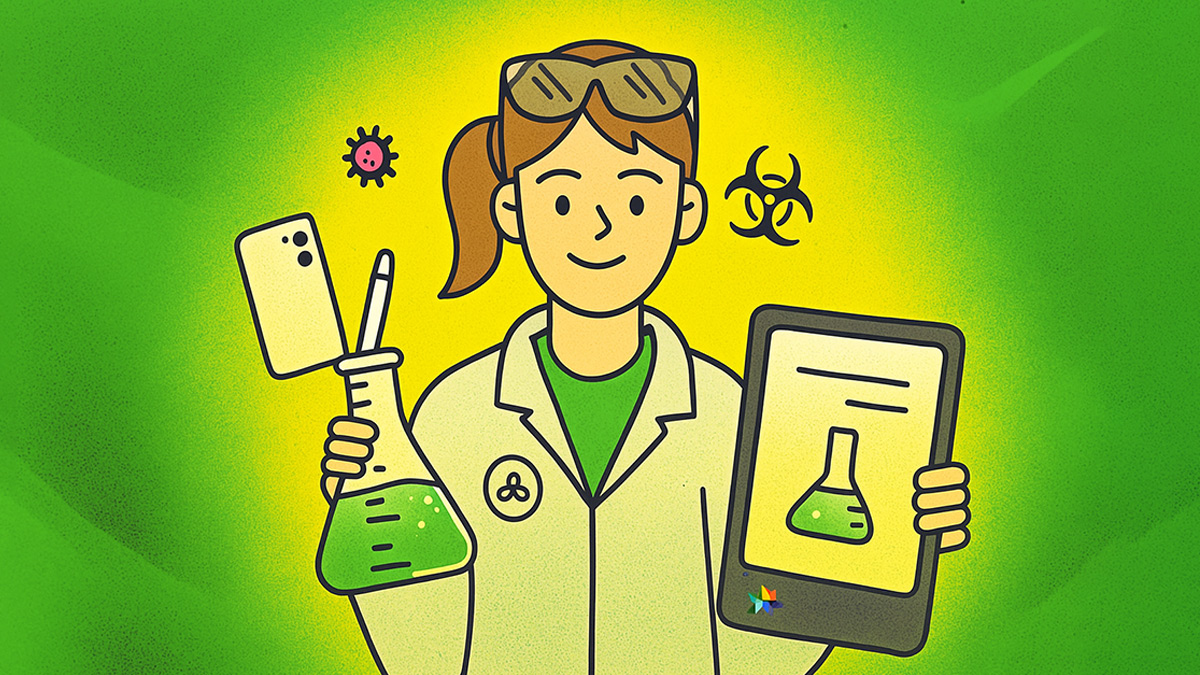Use these free science lab prompts with Gemini to help you translate experiments into clear variables, units, and defendable conclusions. With these prompts you reduce mistakes, document steps, and connect theory to data. Recent education guidance outlines responsible AI use for learning U.S. Department of Education, 2023 and summarizes research-backed study practices Deans for Impact, 2023.
What Are Science Lab Concepts Student Prompts?
These prompts guide you to define variables, units, procedures, and error sources, then link results to core science ideas. They’re built for high school and college students, lab TAs, and teachers who want reproducible methods and concise claims.
They differ from study-guide prompts by focusing on experimental design and measurement. They also complement organized-notes prompts that tidy written records and concept-explanation prompts that clarify theory.
Try the free AI note taker to keep lab notes structured and searchable.
How to Use These AI Science Lab Prompts
Pick 3–5 prompts, paste your source (procedure, data table, image, or notes), then run the steps in Gemini. Export your output to Google Docs or CSV when done. New to AI note-taking? Read the Get Started with AI Note Taking to easily get started.
Variables, Units, and Measurement Prompts (1–22)
Use these to specify independent/dependent variables, constants, units, ranges, and instrument resolution. You will produce clear measurement plans, unit checks, and traceable definitions before collecting data.
- List independent, dependent, and control variables, each with precise SI units.
- Define operational measures for each variable so another group can replicate.
- Suggest realistic value ranges and increments for the independent variable.
- Recommend appropriate measuring instruments and justify their least counts.
- Convert all units to SI, showing factors and final unit consistency checks.
- Flag any mixed units and propose a single coherent unit system to use.
- State constants to hold fixed and explain how you will maintain them.
- Estimate measurement uncertainty from instrument resolution and reading technique.
- Design a calibration step and record the correction factor with uncertainty.
- Choose significant figures for data entry based on instrument precision rules.
- Create a measurement table template including units, trials, and mean columns.
- Explain zeroing or taring procedures to reduce systematic offsets before runs.
- Specify environmental conditions to log: temperature, humidity, and barometric pressure.
- Suggest replicates per condition to achieve reliable means and standard errors.
- Outline labeling conventions for samples, solutions, and trial IDs for traceability.
- Identify dependent-variable proxies if direct measurement is impractical or unsafe.
- Propose a unit-check example calculation to verify dimensional consistency.
- List common reading errors for the chosen instrument and how to avoid them.
- Specify rounding rules for intermediate calculations to prevent drift.
- Decide when to record raw values versus derived quantities with formula references.
- Map variable names to symbols used in equations and figure captions.
- Draft short variable definitions to insert into your lab report methods.
Procedures, Controls, and Safety Prompts (23–44)
Use these to structure stepwise methods, establish control and comparison groups, and embed safety checkpoints. You will minimize confounds and improve reproducibility while documenting protective measures.
- Write a numbered procedure with verbs, materials, times, and stop criteria.
- Add a negative control and explain what outcome validates baseline behavior.
- Add a positive control and state the expected signal or reference curve.
- Identify potential confounders and add steps to isolate the true effect.
- Specify randomization or counterbalancing to reduce bias across conditions.
- Insert timing windows and tolerances to standardize reaction or settling times.
- Create a materials list with quantities, purities, and supplier catalog numbers.
- Add PPE requirements at each step and state the hazard they mitigate.
- Propose ventilation or fume hood use based on reagent volatility and risk.
- Insert waste-handling steps matching local rules and compatible containers.
- Add spill response instructions with first-aid and emergency contact locations.
- Define stopping conditions if temperature, pressure, or current exceeds thresholds.
- Suggest pilot trials to validate feasibility and adjust ranges before full runs.
- Create a checklist for pre-run equipment inspections and calibration checks.
- Define storage conditions for reagents, standards, and biological samples.
- Write a post-run cleanup checklist to prevent cross-contamination in next trials.
- Insert a blinding step where feasible to reduce observer-expectancy bias.
- Specify lot numbers and preparation dates to enable audit and replication.
- Plan temperature controls using water baths, incubators, or ice as appropriate.
- Document deviations and create fields to explain rationale for any changes.
- Schedule mid-run sanity checks to confirm signals fall within expected bounds.
- Summarize the control logic to include in the methods subsection of reports.
Data Tables, Graphs, and Units in Diagrams (45–66)
Use these to build readable data tables and figures with coherent unit labels. You will improve graph selection, axes scaling, captions, and diagram annotations that clarify mechanisms.
- Choose the best plot type for each variable pair and justify the choice.
- Set axis labels with symbols and SI units, plus descriptive axis subtitles.
- Pick axis ranges that include all data and highlight expected operating regions.
- Add error bars using standard deviation or standard error and explain choice.
- Insert a legend keyed to conditions, replicates, or concentration levels.
- Draft figure captions stating question, method, key pattern, and takeaway.
- Show unit conversions in the caption when axes require derived units.
- Generate a data dictionary explaining each column label and measurement notes.
- Propose diagram annotations that clarify mechanism steps with labeled arrows.
- Add units to diagram labels and check dimensional compatibility between steps.
- Create a tidy table template with units in headers and space for notes.
- Recommend smoothing or binning settings without hiding meaningful variation patterns.
- Propose color or symbol encodings that remain readable in grayscale prints.
- Add scale bars or reference lines to contextualize sizes or thresholds.
- Calculate derived variables with formulas shown and units simplified cleanly.
- Suggest log or reciprocal transforms when relationships are nonlinear or heteroscedastic.
- Write axis tick intervals that align with meaningful measurement precision.
- Draft a multi-panel figure plan linking table columns to subplots logically.
- Describe outlier display conventions and when to annotate or exclude points.
- Create a caption template that references figure numbers within the text.
- Check consistency among table, figure, and equation symbols across the report.
- Summarize data-to-figure mapping in one sentence for your methods section.
Error Analysis, Reliability, and Validity Prompts (67–88)
Use these to estimate uncertainty, distinguish random from systematic error, and justify reliability. You will strengthen claims with error propagation, repeatability checks, and validity arguments.
- Classify major error sources as random or systematic with brief rationales.
- Compute mean, range, standard deviation, and standard error for each condition.
- Apply propagation of uncertainty for derived quantities, showing intermediate steps.
- Explain how calibration curves affect bias and report adjusted confidence intervals.
- Recommend additional replicates required to halve standard error estimates.
- Propose inter-rater procedures if human judgment affects any measurement step.
- Design a repeatability check and report percent difference across runs.
- State acceptance criteria that define when data quality is sufficient to conclude.
- Explain ceiling or floor effects and how they might distort observed relationships.
- Assess instrument drift over time and add mid-run recalibration checkpoints.
- Discuss external validity limits given lab conditions versus real-world settings.
- Quantify the likely impact of each systematic error on the final estimate.
- Select a statistical test appropriate for your design and justify assumptions.
- Check normality or variance assumptions and propose nonparametric alternatives.
- Explain Type I and Type II risks in the context of your hypothesis.
- Estimate effect size and power needed to detect your expected difference.
- Draft a limitations paragraph acknowledging uncertainty and next-step improvements.
- Link each limitation to a concrete mitigation you could implement next time.
- Create a table of uncertainties with combined and relative contributions.
- Describe how missing data were handled and the risks of each method.
- Summarize reliability evidence: test-retest, inter-rater, or internal consistency.
- Write one evidence-based conclusion sentence that includes uncertainty bounds.
Concept Links, Models, and Explanations Prompts (89–110)
Use these to connect data patterns to mechanisms, equations, and conceptual diagrams. You will produce short explanations, model fits, and diagrammed processes that make reasoning visible.
- Name the core concept tested and restate it in one plain sentence.
- Map variables to the defining equation and solve symbolically before substitution.
- Fit a linear model and interpret slope, intercept, and R² in context.
- Test a nonlinear alternative and compare fit quality using an appropriate metric.
- Explain causation versus correlation risks given your design and controls.
- Draw a mechanism diagram labeling states, flows, and unit-consistent transitions.
- State assumptions behind the model and which data would falsify them.
- Link each finding to a textbook law or principle with page or section.
- Translate one complex paragraph into a labeled, stepwise algorithm in bullets.
- Propose an everyday analogy that preserves structure without distorting units.
- Write a three-sentence explanation for a classmate who missed the lab.
- Summarize how uncertainty affects the strength of your conceptual claim.
- Draft a claim-evidence-reasoning paragraph linking a figure to theory.
- Note where results contradict expectations and suggest plausible mechanisms.
- Identify one follow-up experiment that could disambiguate between explanations.
- Relate findings to a real-world application with scale and constraints noted.
- Explain how unit conversions might change interpretation in applied contexts.
- Summarize mechanism limits when inputs exceed the tested domain or linearity.
- State which variables matter most and which appear negligible with evidence.
- Create a concept map linking terms, equations, and figures into one diagram.
- Write a plain-language abstract for non-specialists summarizing purpose and result.
- Draft the final conclusion sentence tying back to the original question.
Printable & Offline Options
Download your prompts and outputs as a PDF or copy to Google Docs for lab benches without Wi-Fi. Keep a one-page checklist for variables, units, and safety. See more printable sets at Students’ Prompt Library.
Related Categories
- Explain Concepts: Structured prompts to clarify theory
- Study Guide Prompts: Build tests and review sheets
- Organized Notes: Clean transcripts and lecture notes
- Quizzes & Flashcards: Turn content into practice items
- AI Study-Guide Generator
FAQ
How should I cite AI assistance in lab reports?
Follow your instructor’s policy. In general, acknowledge AI tools in the methods or acknowledgments and verify all calculations and safety steps yourself. Keep prompts and outputs in your appendix for transparency.
Can I use Gemini to generate diagrams with units?
Yes. Provide variables, units, and relationships. Ask for labeled arrows, scale bars, and captions specifying SI units. Always verify dimensional consistency before submission.
What’s the fastest way to estimate uncertainty?
Record instrument resolution and replicate variability. Use standard deviation for spread and propagate uncertainties for derived values. Report significant figures aligned with precision.
How many replicates do I need?
Use at least three per condition as a baseline. Increase replicates until your standard error is small enough that conclusions would not flip with another run.
Where can I find safety guidance?
Consult your institution’s rules and the American Chemical Society’s lab safety guidelines. Add PPE, ventilation, waste, and emergency steps to your procedure.
Final Thoughts
These prompts help you define variables, standardize procedures, and link data to mechanisms. Use them to produce clearer figures, stronger uncertainty estimates, and reproducible conclusions. Want more? Start AI note-taking instantly for free with our AI note taker.
References: U.S. Department of Education, 2023; American Chemical Society, 2023.



